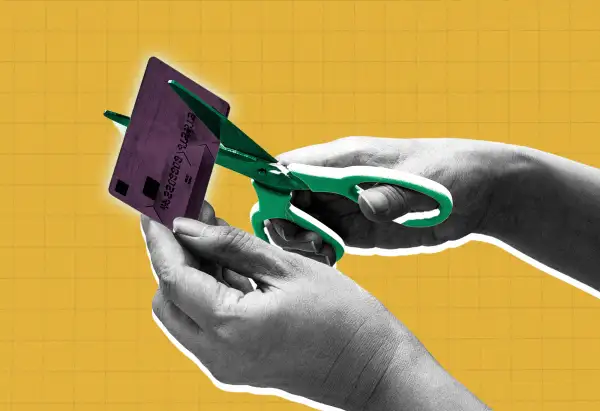Debit Card Fraud Is on the Rise. Here's What I Did When It Happened to Me

A few weeks ago, I stopped at a gas station I don’t typically visit. I paid at the pump with my debit card like usual, filled up and went on my way. But a few days later, I spotted several strange transactions in my bank account. Some were for just a few dollars; others were in the hundreds.
That’s when I realized my debit card information had been stolen.
I suspect my card was skimmed at the gas station. Skimming is a common tactic whereby criminals install discreet devices and tiny cameras on point-of-sale terminals to steal people's debit card numbers and PINs. This kind of theft is increasingly common — as I learned the hard way.
Debit card fraud is growing, fueled by advancements in skimming technology and data breaches. According to the Federal Reserve, debit card fraud was the most common method of payment fraud in the U.S. in 2024, with 73% of banks reporting incidents. The actual losses increased by 6% from 2023 to 2024.
Debit cards are particularly vulnerable because they draw directly from your checking account. Unlike credit cards, which offer more robust fraud protections and don't impact your available cash immediately, debit card fraud can have an immediate and damaging effect on your finances.
As debit card fraud continues to climb, understanding the right steps to take if it happens to you has never been more crucial for safeguarding your money and identity. Drawing from my own experience, I’ll walk you through the process and share insights from Paul Benda, executive vice president of risk, fraud and cybersecurity at the American Bankers Association.
Step one: Contact your bank immediately
I caught the fraudulent charges quickly because of a habit I picked up nearly 20 years ago: Every morning, without fail, I check my bank balance online. This routine of reviewing transactions daily was key to spotting suspicious activity as soon as it occurred.
When I saw the fraudulent charges, I called my bank’s fraud department. The customer service rep quickly froze my debit card to prevent further activity and issued me a new one with a different number.
Acting fast is essential. Under the Electronic Fund Transfer Act, your liability for unauthorized debit card transactions depends on how quickly you report the loss. If you notify your bank within two business days of discovering the fraud, your liability — the maximum you can be on the hook for — is capped at $50. After two days, that cap increases to $500. And if you wait more than 60 days, you could be liable for the entire stolen amount.
In my case, I contacted my bank within 24 hours, which helped limit my exposure and begin the reimbursement process promptly.
Once the charges hit my account, my bank quickly agreed that they were fraudulent and refunded my money. According to Benda, from the American Bankers Association, my history with my bank served me well.
“They knew you as a customer, and they knew that your card had been compromised,” Benda says. “But if you’re a new customer with the bank or if the charges are similar to what you’d normally make, the bank will probably have more investigating to do.”
As I navigated the dispute process, I kept a detailed record of all the unauthorized transactions, writing down when I noticed them, whom I spoke with at the bank and what steps they had taken. This helped a lot.
Step two: Report the fraud to the FTC
Even though my situation was limited to debit card misuse, I went ahead and reported the fraud to the Federal Trade Commission, or FTC, through its official site, IdentityTheft.gov. The FTC allows you to file a report and receive an Identity Theft Report, which serves as official documentation of the incident.
The FTC also provides a personalized recovery plan and resources if the fraud turns out to be part of a larger identity theft issue — something that’s increasingly common when card data is stolen in conjunction with other personal information.
While my incident involved only my debit card, reporting it to the federal government added another layer of protection and credibility to my case.
Step three: File a police report
Filing a police report may seem like overkill for debit card fraud, but getting this documentation is a smart move. Some banks or credit monitoring services may request a police report as proof if you’re disputing extensive fraud or if the theft is connected to other identity crimes.
“Having the documentation that you gathered is really helpful in case you need it,” Benda says. “It’s better to have it and not need it than need it and not have it, right?”
I brought printed copies of my FTC report, a recent bank statement highlighting the unauthorized charges and my ID to the local police department. The officer I spoke with explained that having a report on file helps law enforcement track local fraud trends, and it can also support any future claims I might need to make.
Step four: Notify the credit bureaus
While debit card fraud doesn’t usually impact your credit report, I wanted to be cautious. If your card information is compromised, there’s always a chance your broader identity could be at risk — especially if the theft occurred as part of a larger data breach.
I contacted Experian and placed a fraud alert on my file. This free service requires lenders to take additional steps to verify your identity before opening new accounts. Fraud alerts last for one year and can be renewed. You have to contact only one of the three consumer credit bureaus — Experian, Equifax or TransUnion — for a fraud alert to be placed across all of their services.
I “went above and beyond” by contacting Experian, Benda says. But he explains that if I had seen any sign of more serious identity misuse, I could also have opted for a credit freeze, which prevents anyone from accessing your credit report entirely until you lift the freeze.
“It’s not right for everyone, but it is something that I think people should consider,” he adds.
Step five: Update your security and account settings
After getting my new debit card, I immediately changed the PIN. I also reviewed all accounts that used my old card for automatic payments and updated them.
In addition to correcting my payment details, I changed several passwords and security questions for my online banking and shopping accounts. I made sure they were strong and unique to prevent further compromise.
If you use the same PIN or password in multiple places, a data thief could try accessing other financial platforms or services. This is why it's crucial to treat a debit card theft as a potential gateway to wider identity fraud.
How to protect yourself from debit card fraud
After going through the hassle of having my debit card information stolen, I realized the importance of not just reacting to fraud but actively working to prevent it.
Always be cautious when using payment terminals in public places. If something looks suspicious — like the card reader is loose or bulky — use another trusted payment method. In fact, you might want to avoid inserting your card or swiping it at all, because skimming devices today can be undetectable.
Swiping a debit card exposes its magnetic stripe, which is unencrypted and much easier for criminals to skim using hidden devices (like those often found at gas stations or ATMs). When you swipe a card, the terminal reads the magnetic stripe on the back. This stripe contains static information, meaning it's the same data every time you use it. Criminals can easily copy this info and then use it to create counterfeit cards or make fraudulent transactions.
In contrast, when you insert a chip-enabled card into a terminal, the chip generates a unique, encrypted code for each transaction. Even if a criminal intercepts the data from one transaction, they cannot reuse it to make additional purchases.
However, Benda says that tapping your card (using contactless payment technology) is by far the safest way to make transactions. When you tap, skimming devices simply can't capture the information from your magnetic stripe or chip.
Whatever payment method you use, Benda recommends covering the keypad when entering your PIN. You may also want to sign up for text alerts from your bank whenever a charge is made with your card.
Having your debit card information stolen is frustrating and, frankly, a little scary. But the worst thing you can do is ignore it. In my case, acting quickly meant my bank reversed the charges, issued a new card and secured my account before any more damage was done.
Debit card fraud isn’t going away anytime soon. In fact, it’s getting worse. With the right steps — and the right mindset — you can protect yourself, recover your money and prevent further harm.
More from Money:




